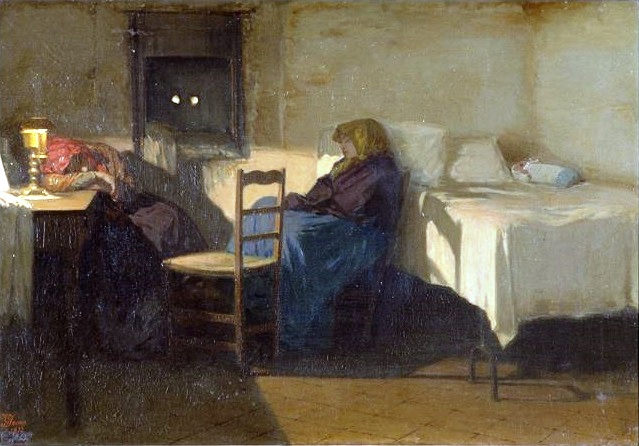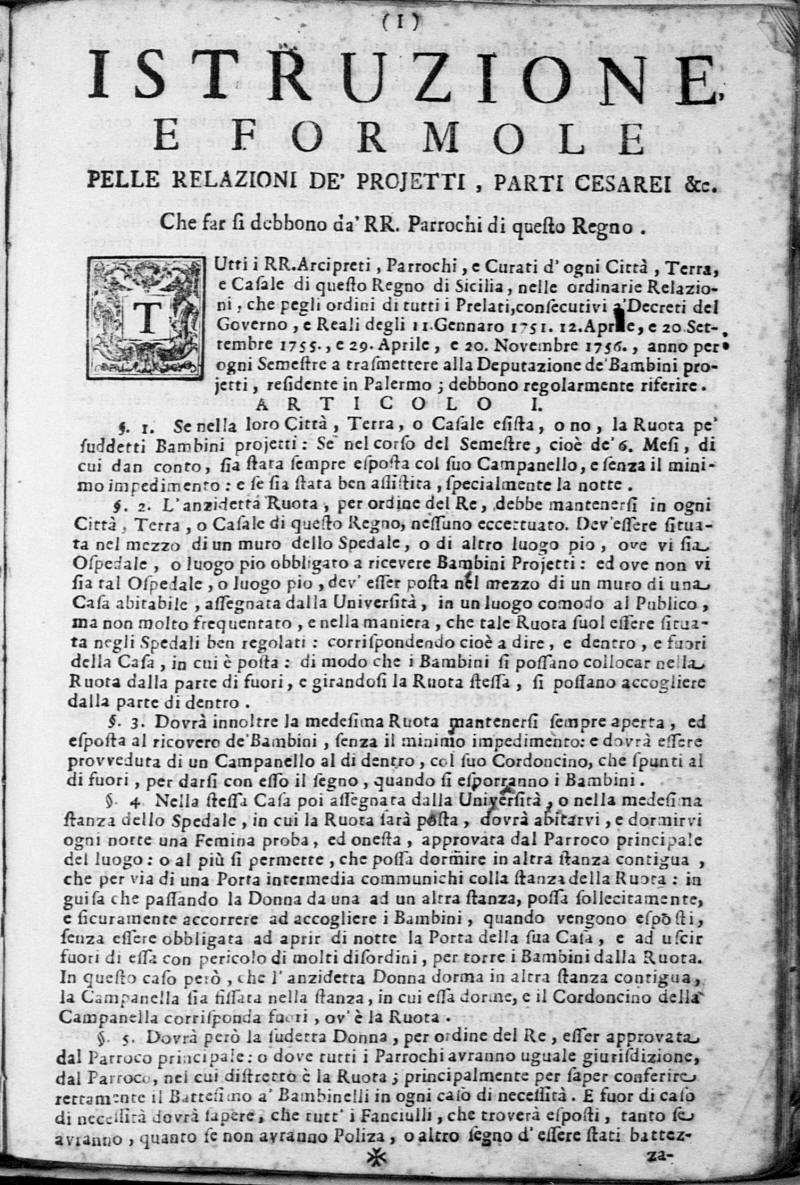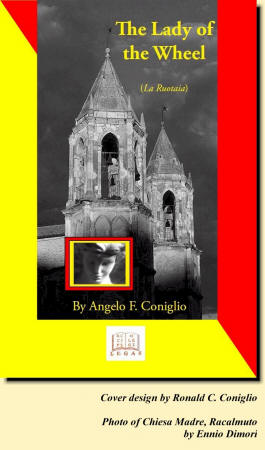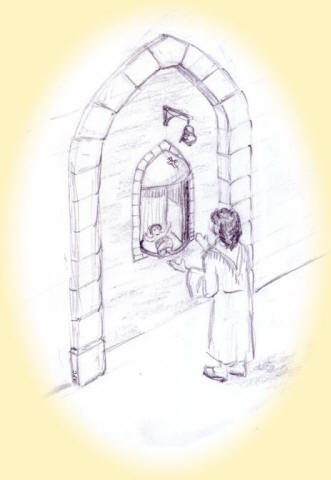In my genealogic research of Sicilian
and Italian records, I have been able to trace many families back
through several generations, into the early 1700s and even earlier.
I have almost invariably found that there was at least one
'brick wall' in each of these families, where the line started with a
child for whom both parents were listed on the civil
registration of birth in Italian as 'padre ignoto'
and 'madre ignota' or 'genitori
ignoti' (father unknown, mother unknown, or parents
unknown). Another way it was expressed was to follow the
individual's name with the term "d'ignoti", e.g.
"Maria Esposta d'ignoti", meaning "Maria Esposta
of unknown [parents]".
On earlier baptismal records, the parents of these children were
listed in Latin as 'genitoribus incogniti' or 'parentis
incogniti'. The
Italian and Latin terms mean the same thing. A more
pejorative term is used in some towns: 'padre incerto'
(father uncertain). Church records may also
describe foundlings as 'filius/filia universitatis'
(son/daughter of the community).
(Note: this page is about abandoned
children, whose parents are unknown. For a discussion
of orphans, whose parents are
known, but deceased, see
bit.ly/OrphansIllegitimatesFoundlings)
THE CAUSES: Infant abandonment was widespread,
for a variety of reasons. For one, unwed pregnancy was
a social disgrace, not only for the unwed mother but for her
entire family. Another obvious reason for abandonment was the extreme
poverty of most citizens of the 'Mezzogiorno', as
the southern Apennine peninsula and insular Sicily are known. And in some regions,
large complements of men, often far from home at sulfur,
salt, or potash mines brought high prostitution rates and subsequent
illegitimate births.
At least outwardly, church authorities were
zealous in protecting the identities of unwed mothers, and
saving 'face' for them and their families. A
more important motive was that the church considered
newborns as 'Turchi' (Turks) or heathens, who could
not be saved unless they were baptized. Sadly, its
concern for these children after baptism often was
not as great, once their souls were saved.
In addition to the church, civil officials were
also concerned with these cases because often the cost of the care of
such infants fell to the civil authorities. The
situation devolved to the point that many towns, both on
mainland Italy and the island of Sicily, installed a device
called 'la ruota (or rota) dei proietti': the wheel of the
castoffs, or 'the foundling wheel'. These wheels could
be in the outside walls of churches or convents, or in
larger cities, in the walls of foundling hospitals or
orphanages.
THE WHEEL: The wheel ('ruota' or 'rota';
in some places called the 'torno' or 'tornio') was a kind of 'lazy Susan'
that had a small platform on which a baby could be placed,
then rotated into the building, without anyone on the inside
seeing the person abandoning the child. That person
then pulled a cord on the outside of the building, causing
an internal bell or chimes to ring, alerting those inside
that an infant had been deposited. In the larger
towns, foundlings were baptized, then kept in a foundling
home with others, and fed by wet-nurses in the employ of the
home. There they may have stayed for several years
until they were taken by townspeople as menial servants or
laborers, or placed with a foster family. Or,
sadly but more likely, they never left the institution,
having died from malnutrition or from
diseases passed on by the wet-nurses.
In smaller towns, the foundling wheel may have
been in the wall of the residence of a local midwife.
She would have received the child, possibly suckled it
immediately to keep it alive, or arranged for a wet-nurse to
do so, then taken it to the church to be
baptized and to the town hall to be registered.
She then consigned a wet-nurse living in or near the town
to take the child and provide sustenance, for a monthly
stipend paid by the town. If the child was near death
when found, many midwives were authorized by the church to
baptize the infant, 'so that its soul would not be lost'.
Civil officials were often similarly authorized.
As bizarre
as the concept of the foundling wheel may seem to
some, the practice still exists to this day, in
countries around the world.
Instead of a wheel, unwanted children are placed in a
receptacle similar to a bank's 'night deposit box',
a called a 'baby hatch' or 'baby box'.
The article at the right was published by the Associated
Press on 13 February, 2023. |
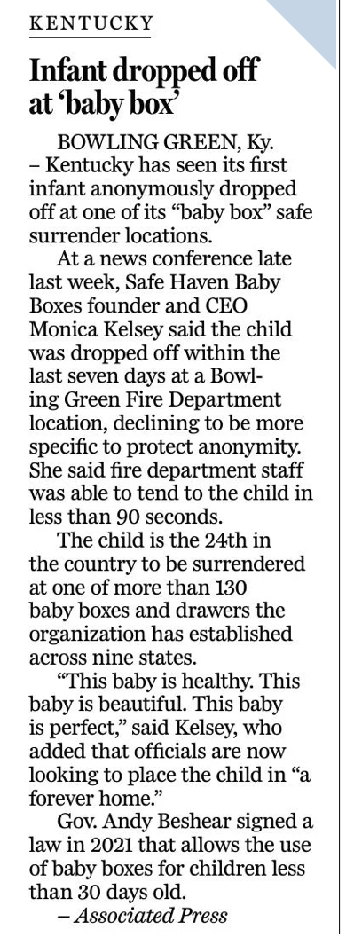 |
Sometimes children were literally abandoned on
the street or on a doorstep, but the use of the foundling
wheel was so widespread that even these children were
often referred to as having been 'found in the wheel'. The
painting below, by Giaoacchino Toma, a 19th-century a artist
from Galatina, in the Kingdom of the Two Sicilies, is
entitled 'La
Guardia alla Ruota dei Trovatelli'
('The vigil at the foundling wheel').
Below is my interpretation of a story about
foundlings that was posted in Italian at the site
http://www.cognomix.it/
The Real Casa Santa
Annunziata [Royal Holy
Annunciation Home] of Naples was an
ancient institution devoted to the
reception of abandoned babies. It
was created in the fourteenth
century along with the "ruota
[wheel]", a kind of wooden
cylindrical drum where the children
were placed, then gathered inside by
nurses ready to intervene at every
call. The "wheel" was closed June
22, 1875, but infants were admitted
to the foundling home until 1980.
Residents of the institution were
called "sons of the Virgin,"
"Children of Nunziata" or "espositi
[exposed ones]", that is, exposed to the
protection of Our Lady. Hence the
surname Esposito, of which we
have the first written evidence in
the archives of the Royal House of
Naples [in what was then the Kingdom
of Sicily] with a "Fabritio Esposito,
age two years, cast off" at the
Annunziata on 1 January 1623 at
three-thirty AM.
This surname was used for all the
"abandoned" until 1814 when Joachim
Murat, the French general, brother
of Napoleon Bonaparte and finally
the King of mainland Sicily, eliminated the
practice. The surname Esposito is
still the most widespread in the
region of Campania. |
|
 |
|
The wheel in which
foundlings were placed |
|
The surname Esposito, regarded
as a stigma, could no longer be
used: it was the duty of the civil
authorities, therefore, who recorded
the arrival of the children, having
to invent a surname every day.
The foundling home staff let themselves
be inspired by everyday life: if the
sun was shining, the orphans of that
day would be called Splendente
[Shining]; if someone knocked on the
door at the time of the first
abandonment of the day, the last name
would be Tocco "Tapping", and
so on.
The eminent sculptor and designer
Vincenzo Gemito was placed in the
wheel on 17 July, 1852 (the day
after his birth), and was given the
surname Genito ("that which
is generated, a son"), which later,
due to an error in transcription,
became Gemito. |
|
http://www.cognomix.it/
paraphrased the above from an October 2013 article in
il Mattino which says:
"That name, 'Esposito', which tells the
child's origin, was considered a stigma, which made life
impossible for people who grew up at the Annunziata."
Il Mattino adds: "The foundling
wheel was created to accommodate only babies, but desperate
mothers also left older children, sprinkling them with oil
to allow them to fit into the mechanism. Too often, that
passage caused fractures and internal injuries; so to
prevent abandonment of older children, the space to lay the
children was reduced from a hand's-width to three quarters
of a hand's-width."
THE RECORDS: Throughout Europe, church records, dating in some
towns from 1540, were kept of all baptisms, even those of
foundlings. Generally, church records didn't even give
any surname for a foundlings, just a 'given name' and the
notation 'parentibus ignoti' as in 'Phillipus
parentibus ignoti' (Filippo, unknown parents). Such
children went through life with only a first name and the
handle 'foundling'. Often they simply adopted a
nickname or descriptive surname to distinguish themselves
from other 'Filippo's'.
From about 1809 - 1820, influenced by
Napoleon's 'civil code', civil records of
birth were instituted
in northern Apennine duchies and principalities like Venice
and Genoa and in the Kingdom of Sicily stretching from Abruzzo and Napoli on the mainland to Messina and Palermo on
insular Sicily. From that time, not only were
foundlings' baptisms recorded at churches, but each child was
civilly registered by the town's 'Uffiziale dello Stato
Civile', the Official of Civil Status, in the civil
'Atti di Nascita', or Records of Birth. For
ordinary births,
such records gave the date; names and occupations of the
parents; and the name of the child. In the usual case, there
was no other description of the child, besides its gender.
Civil birth records for foundlings were
different. The 'dichiarante', or declarant (the
person presenting the child, in ordinary cases its father) was
identified by a title, which varied by town. In many,
as in Serradifalco, on the island of Sicily, the title was 'ricevitrice dei
proietti', 'receiver of castoffs'. In other towns, like Sora on the mainland, it was 'custode della
ruota dei proietti', or 'keeper of the wheel of the
castoffs'. But the most poignant, to me, was the simple
term used in the Sicilian village of Racalmuto, namely 'ruotaia':
'wheel-lady', or 'lady of the wheel'. In other towns
variations such as 'rotaia' or 'rotara' were
used, with the
same meaning.
Note: Often, "proietto"
and "ruotaia" are written as "projetto" and
"ruotaja". The letter that looks like the English
letter "j" is not a "j" at all, but the letter "i" with a
long tail. It was often written that way when it
appears between two other vowels, and it is pronounced the
same way as "y" is pronounced in English: hence "pro-YETT-oh"
and "ruoh-TY-uh". The "i with a tail"
often appears in other words and proper names, such as "calzolajo"
(shoemaker), Ajello, Saja, and so on. The
Italian word "progetto" meaning "project", as in a building
project, is pronounced "pro-JETT-oh" (where the "g"
sounds like the English "j"!) and has a completely different
meaning.
Rather than simply giving the child's
gender, the civil registration document of a foundling usually
stated where it was found: 'nella ruota pubblica in
questa comune' ~ 'in the public wheel of this town'; or
if appropriate, on whatever street or doorstep it was found.
If the child had evident birthmarks (or none), that fact was
noted, along with a description of the clothing or any
'tokens' found on the baby. Some records stated that
the midwife had arranged to initially feed the child and
that it had then been consigned, according to law, to a 'nutrice',
a wet-nurse; sometimes the name of the wet-nurse was given.
From the early 1800s until 1865, civil records were kept on
pre-printed forms in a format originally specified by the
Napoleonic Code. The extra information
recorded for foundlings did not fit in the blanks, so often
the written information did not fit the preprinted category.
In some cases, the information was 'squeezed' into the
preprinted form, but frequently the civil
Register of Births had a 'Parte Seconda' (Part 2) and the
foundlings were registered in that section, filed after
the main portion (Part 1) of the register. These Part
2 foundling records were completely handwritten. Other
non-standard births (e.g. late announcements) might also be
filed in Part 2.
In
some towns, including Palermo and Catania, there was a
complete separate register for foundling births, In some
larger cities, all foundlings were abandoned at, or brought
by their discoverers to, an ospedale, orfanotrofio,
or brefatrofio (foundling home), which prepared
its own records and also submitted the information to civil
authorities to be registered. The
earliest civil records followed the church's policy of
simply giving foundlings first names, with the suffix
'foundling', later, they would give a concocted surname
followed by 'foundling', as 'Filippo Faccilorda, esposto'.
Civil records after 1865 gave only a made-up first name and
surname, but the body of the record itself clearly indicated
that the child was a foundling.
In some locales and eras, the abandonment of children
by their unwed mothers was essentially imposed by
civil and church authorities. Town priests and
midwives closely scrutinized young single women, and if they
discovered a pregnancy, the expectant mother was 'encouraged' to give
the child up, to avoid familial disgrace, and, more
importantly to the church, to assure that the infant was
baptized before it died. Though the use of the wheel
was nominally secret, many institutions required alms or
payment by the mothers, so there was a 'paper trail' of
evidence even though the general public was supposedly
unaware of the particulars. If a mother was unable to
pay alms, often she was required to work for free in the
institution as a wet-nurse.
Such activities could not long be kept secret
from the community, and although the names of foundlings'
parents were not officially recorded, no doubt in small
communities the true relationships were known. In some
cases, a mother would volunteer to take her own child to her
home to wet-nurse, though 'officially' the infant's parents
were unknown.
Unless an abandoned child's parentage was officially
established at some later date, most commonly by a
rectification (specifically, a "legittimazione" or
"legitimization") that was filed to give the names of one or
both parents, or on the post-birth marriage record of
its parents, the child was always officially referred to by
its imposed name and as the child of unknown parents.
When such a child married, even though he and everyone in
the community might have known who his parents were, if no official
correction had been made, his marriage record would list his
parents as 'genitori ignoti'.
Some children may have been abandoned because their
parents were unmarried, or married in church ceremonies not
recognized by civil authorities. If the couple was later
married in a civil ceremony, the names of the children they
had abandoned and their birth dates would be stated in the
couple's civil marriage record, thus acknowledging and
'legitimizing' the former foundlings.
Like those of all citizens, foundlings' birth,
marriage, or death records, or rectifications, are kept
permanently in the Anagrafe or Registry Office of
each town, with a copy in provincial or tribunal archives.
These records may be searched in person, or in many cases
viewed on microfilm produced by the Mormon church, or
on-line at genealogy sites. Records of the disposition
of abandoned children to wet-nurses or to foster homes may
exist, but they are less easily uncovered and usually
require on-site research at the towns, churches, or
provinces involved.
These original birth records often reflect the large
proportion of foundling births in a town. In Racalmuto,
for example, in the year 1880, there were five hundred and
twenty four legitimate births recorded, and
eighty-three infants left in the wheel, a staggering
fourteen percent of all births! Other years, and
other towns, show similar statistics. For example, the
index of baptisms of the Mussomeli church records for the
years 1831 through 1845 lists baptisms alphabetically by the
first name of the infant's father. There are several
pages of names beginning with "P", dozens of them reading
'Parentis Incogniti' ~ 'parents unknown'.

In some cases
infants were not
actually left somewhere, but
were reported by a midwife as having been delivered by her, from "una donna che non
consente essere nominata" - "a woman who does not
consent to be named", and neither was a father named.
In these cases, even though the midwife obviously knew the
identity of the mother, she was officially unknown, as was
the infant's father.
'FOUNDLING' (trovatello) versus 'ABANDONED CHILD' (abbandonato): There
is a tendency to use these two terms to mean the same thing.
There can be a difference, however.
Clearly, infants who were found
in 'the wheel', on a doorstep, in the woods, or in the
middle of the road were abandoned before they
were found.
But there
is another class of abandoned children, as noted above;
those who were delivered by a midwife to an unnamed woman who would
not or could not name the child's father. In these
cases, the mother of the child abandoned the child to the
midwife and hence to the local authorities. She was
known only to the midwife, not reported in the record of
birth, so she was 'officially' unknown, as was the father.
Hence, while all foundlings were abandoned
children, not all abandoned children were strictly
foundlings.
In its effect on the future of the infant,
the results were the same, whether the child was abandoned
to the wheel or abandoned to a midwife. While not
strictly 'found', the latter, just as for an actual
'foundling', was given a concocted name, consigned to a
wet-nurse or home for abandoned children, and future
official references to his parents would list both of them
as unknown. See the case study for
Santa Venerdi Proietta, below.
If an unwed woman was named in her
child's record of birth, but she did not name its father, it
would then bear her surname, as an illegitimate
child, but not a foundling.
NAMES: Although their parents were at least
'officially' unknown,
foundlings had to be given some kind of name, and this was
done by the receiver of foundlings, or the priest baptizing
the child, or the civil official registering the event.
On an ordinary birth or baptism record, usually only the
given ('first') name of the baby was recorded, since its
surname was the same as its father's. But with
foundlings, the given and the surname were recorded.
Both, of course, were 'made-up', and in the earliest
records, first names were recorded, followed by a word
that was synonymous with 'foundling', as in Pietro
proietto.
'Proietto' meant
'castoff' or 'thrown away' in early Italian, and consideration of
the word's Latin origin sheds some light on the way
foundlings were looked upon. The origin of 'proietto'
was the Latin 'proiectus' (written 'projectus' in
cursive), and early church baptisms
used 'Projectus' as a surname for foundlings.
One meaning of 'proiectus' was 'cast' or 'thrown'. But
Latin dictionaries give secondary meanings: 'lowlife';
'miserable'; 'deplorable'; 'honorless'; 'lamentable'; and
many more similar meanings. Such was the view
they had of these parentless infants.
Other surnames clearly
meaning 'foundling' or 'abandoned' include Trovato (found),
Abbandonata (abandoned), or
Esposto/Esposito (exposed). In the
various duchies, principalities and other states on the
mainland, at baptism, frequently a foundling was given a saint's name or
other made-up name as a first name, then a surname that was
the Latin possessive form of the same name, for example Genesius
Genesi (Genesius, son of Genesius) or Amatus
Amati
(Amatus, son of Amatus). Such 'first' or given
names were then Italianized in the civil records, resulting
in Genesio for Genesius; Amato for Amatus, etc.
Sometimes a foundling listed by only its first name and
followed by "d'ignoti" eventually had the descriptive
term capitalized and evolved into a surname, D'ignoti
or Dignoti.
In Roma, where a foundling's mother was
often listed as "m. ignota" (madre ignota, mother
unknown), a pejorative term was "figlio di Mignotta!"
that is, "Son of an unknown mother!" Since most foundlings
were illegitimate, that was a 'polite' way of calling
someone a bastard.
Note: On the death record of a foundling, their
parents' names were invariably listed as padre ignoto
and madre ignoto, or the foundlings were referred to
as d'ignoti. These terms did not mean that the
parents' names were simply unknown to the clerk or
declarants of a record, they meant that the person was
a foundling. If it was intended to convey that
the person was not a foundling, but their parents were not
known to anyone in the proceeding, in the place for the
parents' names, the clerk would enter "s'ignorano"
(the names are not known to us).
The descriptive 'foundling surname'
eventually became the person's official surname.
When a foundling boy grew up, married and had
children, the
children's surnames would be the same as their father's even
though they themselves were not foundlings. Many of
these surnames exist to this day, with their bearers having
no idea that somewhere in their ancestry there was a
foundling child.
Even the given names of foundlings were
often unusual or fantastic, like Cleopatra or
Romulo. When surnames other than Proietto,
etc. began to be used, they, too were unusual and often
stigmatic, like Urbino
(blind); lo Guasto (crippled);
Milingiana (eggplant); and Vinagro
(bitter wine). A child with such a name was marked
throughout his or her life as one with 'genitori ignoti'
(unknown parents) and
by inference, as a love child, although at least in theory,
it wasn't known whether or not the child was abandoned by a married
woman who conceived it in wedlock. Even children with
less insulting surnames were thusly scorned. Di Dio
(of god); D'Angelo (of an angel); del Popolo
(of the people); degli Uomini
(of the men); di Giugno
(born in June) and Gelsomino (jasmine) are all mild
enough surnames, but in certain towns they were used
exclusively for foundlings, and marked them just as surely
as the cruder versions.
Below is a poignant example of a name given to a child found
in the town of Montemaggiore Belsito on the
morning of 29 June 1835, in the public wheel of the 'House
of Castoffs'. She was found and presented by the
Ruotara (female wheel-keeper) Francesca Ippolito, age
29. The infant was a girl, wrapped in ragged digapers,
without any birthmark or token, and was given the name
Diana, and the surname Cacciatrice.
In Italian, the word "cacciatore" signifies "hunter"; the
feminine form is "cacciatrice", meaning 'female hunter", or
"huntress". So a flippant official gave the
unfortunate child the name "Diana the Huntress",
possibly to show off his knowledge of Roman mythology.
Regardless, it would be recognized by one and all
as a "foundling name", and the girl would bear that stigma
all her life.
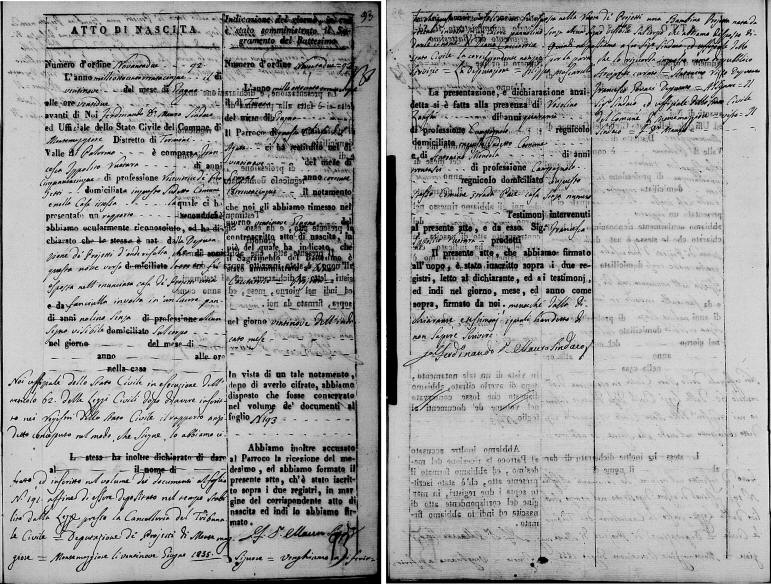
Eventually, laws were passed
prohibiting the stigmatic names, but in small towns, because
the names were made up, they were invariably different than
the surnames usually occurring there. Often such names
carried a 'foreign' implication: Lopez,
Romagnoli, Suez and even Miller
have appeared as surnames in Sicilian birth records.
These may be valid names, derived from ancestral
ethnicities, or they may have been names concocted for
foundlings. The surname Miller, for example,
may have been given to a foundling because the midwife,
receiver of foundlings or civil official knew
(without officially revealing it) that the infant's father
was an Englishman named Miller; or assumed that to be
the case; or simply chose Miller to show that
the child was 'not from here, not legitimate'.
Coniglio
is a perfectly valid Italian/Sicilian surname, but in a town
of only 1,500 souls, where no one else had the surname
Coniglio, any child with that name was obviously a
foundling. In some cases, a foundling was simply
given the name of his village as a surname: thus,
Giuseppe Vallelunga, Rosa Siragusa, etc.
However, it was more common to give foundlings the name of
some other town, or a modification of a town
name to indicate 'from the town', such as Barese,
Palermitano, Tirminisi, etc.
This also marked the child as a
'stranger' or the child of a stranger. Place names as
surnames, I believe, were more common as foundling names
than they were as places of origin. For a more detailed analysis of
Sicilian town place-names as surnames, click
HERE.
|
Typical Foundling Surnames and Towns in
Which They Were Prevalent |
|
|
SURNAME |
MEANING |
TOWN |
|
Abbandonata |
abandoned |
Sora (Frosinone) |
|
Asinello |
little ass |
Mussomeli
(Caltanissetta) |
|
Cagnazzi |
bitches |
Santeramo (Bari) |
|
di Dio |
[child] of
God |
Castrogiovanni
(now Enna, Enna)
San Piero Patti
(Messina)
Valguarnera Caropepe
(Enna) |
Esposto,
Esposito |
exposed |
Serradifalco
(Caltanissetta)
numerous others |
|
Gelsomino |
jasmine flower |
Montemaggiore Belsito
(Palermo)
Mussomeli |
|
Giumento |
mare |
San Cataldo
(Caltanissetta)
Serradifalco |
|
Milingiana |
eggplant |
Serradifalco |
|
Miller |
[yes, Miller] |
Serradifalco |
|
del Popolo |
[child] of the people |
Castiglione (Catania)
Montalbano di Elicona (Messina)
Linguaglossa (Catania) |
|
Pampinella |
leaflet, sprig |
Altavilla
(Palermo)
Baucina (Palermo)
Santa Flavia (Palermo) |
|
Portoghese |
Portuguese |
Trapani (Trapani) |
|
Proietto |
castoff |
Racalmuto (Agrigento) |
|
Spavento |
fright |
Mussomeli |
|
Spurio |
spurious |
Mussomeli |
|
Trovatello |
little foundling |
Sant'Angelo Brolo
(Messina) |
|
Trovato |
foundling |
Acireale
(Messina)
Alcamo (Trapani)
Valguarnera (Enna)
numerous others |
|
Tulipano |
tulip |
Mussomeli |
| |
|
|
ALIASES: While
abandonment of children born out of wedlock was sanctioned
by both Church and State, it was illegal for a married
couple to abandon a child. Though there were some
cases in which legal parents saw no other recourse, the
overwhelming majority of foundlings were illegitimate
children, to the extent that the word 'foundling' or any of
its variations was synonymous with 'illegitimate'.
If you were a foundling, you were a bastard child,
considered by society the lowest of the lowest social class.
Because of such stigma, on reaching
adulthood, many foundlings took less stigmatic surnames
rather than Proietto, Esposito, or the formulaic, contrived,
and unique surnames that had been concocted for them.
These self-chosen names were usually simply common surnames
in their villages, not necessarily with any familial
connection. In some cases the new names were legally granted
by the judicial system, but in many instances, the foundling
simply 'went by' a name of their choosing, to the extent
that after being used for some time, it essentially became
their name. Such persons often had both names
recorded, for example, as follows: Giuseppe del Popolo,
inteso Marconi, that
is, 'Giuseppe del Popolo, going
by Marconi'; or Ciro Gelsomino,
detto Faso (Ciro
Gelsomino, called
Faso); or Paolo Proietto, alias
Burgio ('alias'
has the same meaning in Latin, Italian, or English).
When foundlings emigrated, many
immediately changed or modified their names and/or revised
their family stories, claiming to be orphans, or 'love
children' of important figures, nobles, or officials, or
having living legitimate parents left behind, since often
there was no one in their new surroundings who could refute
their claims. See an example in the case study for the
Famiglia Messina.
THE FATE OF FOUNDLINGS: Civil records were and are
open to the public, in 'registri' or registers. Citizens could go to the town hall and ask to see them.
'Unknown' parents of a foundling could therefore see what
name had been given to their child (from the date and the description of
tokens or clothing), and sometimes, to whom the baby had
been consigned. They might then reclaim the child,
although recorded instances of this are few. If a
legally married couple reclaimed a child, they would then go
to the civil authorities for registration of a 'legittimazione',
a correction which would officially name them as parents,
and legitimize the child's birth. Tales are also told
of many a mother who claimed her child without revealing
their relationship, being paid a stipend to wet-nurse her
own child.
In the foundling homes, hospitals or asylums of large
cities, many babies suffered horrific conditions.
Wet-nurses were often of lower classes and carried diseases
passed on to the babies. Children who survived to
early childhood could be 'farmed out' as servants,
field laborers, or worse: often, boys were indentured or
sold to sulfur mine owners or workers as 'carusi'
(mine-boys) to carry raw sulfur out of the mine; and girls
were often sold into prostitution.
These horrendous possibilities, of course didn't preclude the
consignment of foundlings to foster-families that did care for
them responsibly, and raised them to adulthood. Because
of the nature of these arrangements, easily available public
records are hard to come by. At one point in Italy's
history, foundling homes became so crowded, and the total
pay required for the wet-nurses of its inmates so high, that
civil authorities hired 'external wet-nurses' to care for
some infants away from the institutions. They even
sometimes acknowledged unwed mothers and paid them a sort of
child support stipend, to nurse their own children.
This led to some bizarre situations.
In the years following the unification of Sicily with
northern Apennine states (the 'resorgimento'), vast church property was appropriated by the
state, and church and state were at odds. Marriages
that took place solely in church were not recognized by the
civil authorities, and in order for a union (and its
offspring) to be legal, a couple was required to be married
in a civil ceremony, usually at the town hall by a public
official. When the policy of civil stipends to unwed
mothers was instituted, sometimes an expectant mother would
marry in church, avoiding family disgrace, but would not
take the civil vows. This made her child
illegitimate in the eyes of the state, entitling her to
a stipend!
In small towns, the fate of foundlings may
have been somewhat better than in it was in large cities. In smaller communities,
they may not have been subjected to the
crowding of orphanages, but instead were consigned to the individual
families of the wet-nurses. There, though they may
have eventually been required to work in the fields or the family
business, the same as the family's natural children, they
may also have found some measure of acceptance and
normality. However, their names marked them as
foundlings. In a class-conscious society, sons of
landowners married daughters of landowners, daughters of
tradesmen married sons of tradesmen, and foundlings married
foundlings.
IDENTIFYING
FOUNDLINGS' PARENTS:
As
family researchers try to 'build' their family trees further
and further back, many are frustrated by the 'brick wall'
presented by a foundling ancestor. Unfortunately,
exactly because foundlings were intentionally
abandoned by unknown parents, it is virtually impossible to
determine the names of their biological parents. In
many cases, it isn't even possible to determine the names of
the families that raised them.
As early as the 1500's, churches kept
records of baptisms for all children, including those for
whom only one parent was known as well as for foundlings.
In the 1800's, civil registrations of births began to be
recorded. So there can be some clues in foundlings'
birth and baptism records. Civil records give the name
of the receiver of foundlings or the midwife who presented
the child for registration, along with the names of two
witnesses to the registration, and often the name of the
wet-nurse or institution to which the child was consigned.
It's possible that one of those named belonged to a family
that raised the child. Baptism records give the
names of the foundlings' godparents; again, possible foster
parents of the infant.
However, remember that the parents of a
foundling were unknown for a reason: the anonymous
abandonment of children was sanctioned by church and state
to protect the 'honor' and therefore the anonymity of unwed
mothers and their love partners. Even in the rare
cases in which official consignment, fostering or adoption
documents were created, THE BIOLOGICAL PARENTS OF THE
FOUNDLING WOULD NOT BE NAMED in such documents.
With the recent trend towards DNA testing,
it's possible that descendants of relatively recent
foundlings may be able to locate close relatives who can
help to clarify their lineage, but the farther back the
'brick wall' occurred, the less likely that even DNA methods
can help.
Briefly, DNA venues test your DNA,
then compare it to others who have tested, and provide a
list of persons, some of whose DNA matches some of yours.
DNA is measured in centiMorgans, or cM, and the more
cM you share with a "DNA match", the closer your
relationship. If these "DNA matches" have family
trees and are willing to share information with you, you may
find that they have ancestors in common with you. This
may help you to determine the identity, or at least the
close family of the parent or parents of your foundling
ancestor.
For example, say one of your grandparents
was a foundling. That would mean that two of
your eight great grandparents were unknown. We share
great grandparents with our second cousins, however, not
every second cousin is descended from the unknown couple.
To isolate one or both members of the couple, you would
first have to develop your own 'pedigree' or family tree
that identified the six great-grandparents who were NOT the
foundling's parents. Then if you could analyze
the trees of all the second cousin "DNA matches" that you
have, you might be able to determine those who were
descended from your known ancestors. By elimination,
any second cousins who were not descended from your known
ancestors must be descended from one or both of the
foundling's parents, so one or both of those second cousins'
great grandparents are your ancestor(s).
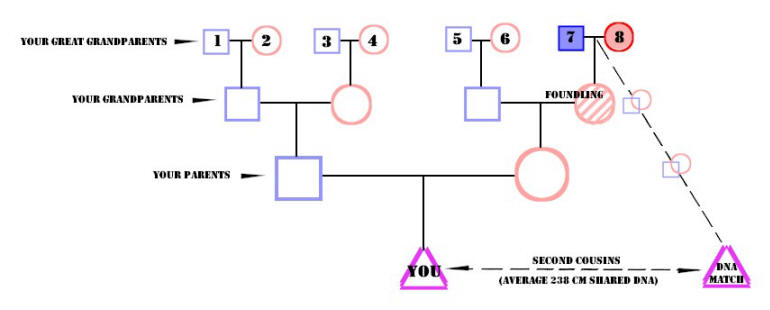
Second cousins, on average, share 238 cM of DNA (actually,
from 43 cM to 504 cM), so you'd have to study your DNA
matches in that range and hope they have trees back to their
great grandparents. In the diagram, great grandparents 7 and
8 are the unknown parents of the foundling, and obviously
would have different names than your known great
grandparents.
The same logic could be applied if your foundling ancestor
was your great grandparent, but in that case, its unknown
parents would be your great-great grandparents, of which you
have sixteen. So you'd have to know fourteen of
the sixteen, and find enough DNA matches who are third
cousins who had trees that could allow the same process of
elimination.
Needless to say, that would be a Herculean task, not likely
to be successful. In general, we usually have to resign
ourselves to the fact that we'll probably never know our foundling
ancestors' true parents.
ADOPTION RECORDS: I have found no official
records pertaining to the formal 'adoption' of foundlings.
In most Sicilian and Italian towns, from early on through
the early nineteen hundreds, adoption was not common and
even illegal, and the only formal adoptions allowed were
those of orphans, that is, children whose parents were
known, but one or both of whom died before the child reached
adulthood.
Adoption of foundlings, whose parents were unknown, was
generally not permitted. Foundlings may have
lived out their lives in a foundling home, or in private
homes as menial servants, or worse; they may have been
consigned to families as persons who worked in exchange for
room and board, or to owners of the quarries or mines in
which they toiled. Even though foundlings' parents
were officially 'unknown', a relative of the foundling, an
aunt, mother or sister of the 'disgraced' true mother, may
have raised the child.
In some cases, they were formally consigned to
official guardians, whose families became the foundling's
foster family. One case of foster parenting can be seen in the case study of Genesio
Genesi, linked below. Even
where there are official consignment papers,
since the foundlings' parents were unknown, that is how the
parents
were listed. No names of birth parents are given in
such papers.
There generally are no official records of any of
these dispositions, however in certain instances couples who
had abandoned children born to them prior to having been
married in a civil ceremony may have later married civilly,
and in their marriage record declared the names of the
children and acknowledged them as their own. For more
detail, click
HERE.
In cities or larger towns, a
child may have been 'farmed out' (even for pay to the
institution): boys as 'carusi'
or child mine workers; girls as servants, or, sadly, as
prostitutes. In many cases, in small towns, these infants
were raised in the families of the wet-nurse to whom they
were consigned, or families which needed an extra set of
hands for field work or other family enterprises.
LEGENDS: A very common explanation many
families were given about a foundling ancestor is a
variation on the following theme: A young girl was working as a
servant in the home of the local prince (or rich
businessman, or priest). She was impregnated by the
man (or his son, etc.), who could or would not marry her, and she left the
baby, of noble or upper-class blood, in the wheel.
Some of those stories may carry a grain of truth;
however, there is usually no way to corroborate them, and I
believe the great majority were fiction, made up to assuage
the shame of families with unwed daughters who had become
pregnant. Hopefully, today the world is less
judgmental.
|
|
The above material is a
synopsis of information from my own research of
Sicilian and Italian birth, marriage and death
records, augmented by correspondence with
genealogist Ann Tatangelo (angelresearch.wordpress.com),
and by the description of foundling management
in the book
Sacrificed for Honor, by David I.
Kertzer. |
 |
|
|
I've been
privileged to be asked to do foundling research for Henry
Louis Gates' PBS series 'Finding Your Roots'.
|
|
I've
contributed to three episodes so far, two with research on
the ancestors of Marisa Tomei, and one future episode that
deals with the heritage of a (presently undisclosed)
Hollywood actor. Click the image below to view the
recent show involving Marisa Tomei. |
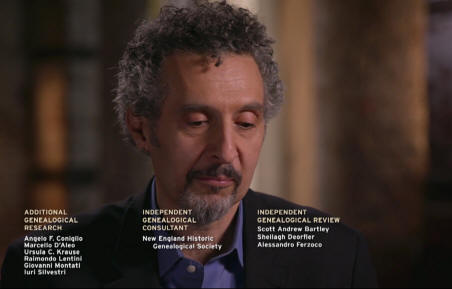 |
 |
|


